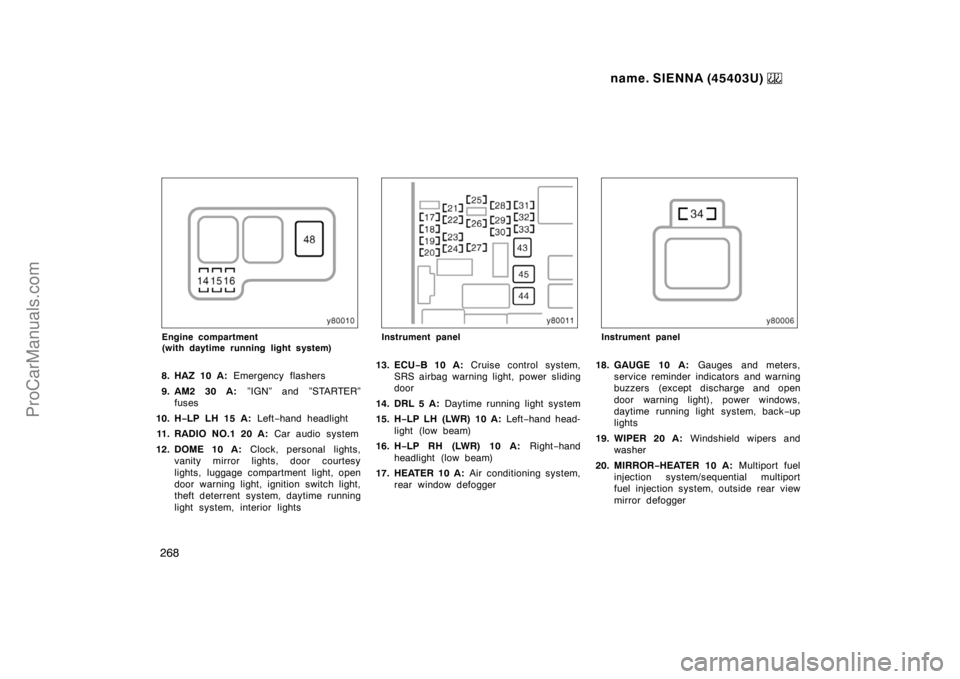Page 113 of 272
name. SIENNA (45403U)
11 3
CAUTION
On some models, since the mirror
surfaces can get hot, keep your
hands off them when the defogger
switch is on.
Make sure you turn the defoggers off
when the surfaces are clear. Leaving the
defoggers on for a long time could cause
the battery to discharge, especially during
stop−and−go driving. The defoggers are
not designed for drying rain water or for
melting snow.
If the outside rear view mirrors are heavi-
ly coated with ice, use a spray de−icer
before operating the switch.
NOTICE
When cleaning the inside of the rear
window, be careful not to scratch or
damage the heater wires.
ProCarManuals.com
Page 195 of 272
name. SIENNA (45403U)
195
Part 3
STARTING AND
DRIVING
�Before starting the engine
�How to start the engine
�Tips for driving in various
conditions
�Winter driving tips
�Tr ailer towing
�How to save fuel and make
your vehicle last longer, too
Before starting the engine
1. Check the area around the vehicle be-
fore entering it.
2. Adjust seat position, seatback angle,
seat cushion angle, head restraint
height and steering wheel angle.
3. Adjust inside and outside rear view
mirrors.
4. Lock all doors.
5. Fasten seat belts.1. Apply the parking brake firmly.
2. Turn off unnecessary lights and acces-
sories.
3. Put the selector lever in ”P”. If you
need to restart the engine while the
vehicle is moving, put the selector le-
ver in ”N”. A starter safety device will
prevent the starter from operating if the
selector lever is in any drive position.
4. Depress the brake pedal and hold it to
the floor until driving off.
How to start the engine—
(a) Before cranking
ProCarManuals.com
Page 202 of 272

name. SIENNA (45403U)
202�
Check that your rear view mirrors con-
form to any applicable federal, state/
provincial or local regulation. If not,
install the rear view mirrors required
for towing purpose.
TRAILER TOWING TIPS
When towing a trailer, your vehicle will
handle differently than when not tow-
ing. The three main causes of vehicle−
trailer accidents are driver error, exces-
sive speed and improper trailer loading.
Keep these in mind when towing:
�Before starting out, check operation of
the lights and all vehicle−trailer connec-
tions. After driving a short distance,
stop and recheck the lights and con-
nections. Before actually towing a trail-
er, practice turning, stopping and back-
ing with a trailer in an area away from
traffic until you learn the feel.
�Backing with a trailer is difficult and
requires practice. Grip the bottom of
the steering wheel and move your hand
to the left to move the trailer to the
left. Move your hand to the right to
move the trailer to the right. (This pro-
cedure is generally opposite to that
when backing without a trailer). Also,
just turn the steering wheel a little at
a time, avoiding sharp or prolonged
turning. Have someone guide you when
backing to reduce the risk of an acci-
dent.
�Because stopping distance may be in-
creased, vehicle−to−vehicle distance
should be increased when towing a
trailer. For each 16 km/h (10 mph) of
speed, allow at least one vehicle and
trailer length between you and the ve-
hicle ahead. Avoid sudden braking as
you may skid, resulting in jackknifing
and loss of control. This is especially
true on wet or slippery surfaces.
�Avoid jerky starts or sudden accelera-
tion.
�Avoid jerky steering and sharp turns.
The trailer could hit your vehicle in a
tight turn. Slow down before making a
turn to avoid the necessity of sudden
braking.
�Remember that when making a turn,
the trailer wheels will be closer than
the vehicle wheels to the inside of the
turn. Therefore, compensate for this by
making a larger than normal turning
radius with your vehicle.
�Crosswinds and rough roads will ad-
versely affect handling of your vehicle
and trailer, causing sway. Pay attention
to the rear from time to time to pre-
pare yourself for being passed by large
trucks or buses, which may cause your
vehicle and trailer to sway. If swaying
happens, firmly grip the steering wheel
and reduce speed immediately but
gradually. Never increase speed. Steer
straight ahead. If you make no extreme
correction with the steering or brakes,
the vehicle and trailer will stabilize.
�Be careful when passing other ve-
hicles. Passing requires considerable
distance. After passing a vehicle, do
not forget the length of your trailer and
be sure you have plenty of room be-
fore changing lanes.
�In order to maintain engine braking effi-
ciency, do not use overdrive.
ProCarManuals.com
Page 268 of 272

name. SIENNA (45403U)
268
Engine compartment
(with daytime running light system)
8. HAZ 10 A: Emergency flashers
9. AM2 30 A: ”IGN” and ”STARTER”
fuses
10. H−LP LH 15 A: Left−hand headlight
11. RADIO NO.1 20 A: Car audio system
12. DOME 10 A: Clock, personal lights,
vanity mirror lights, door courtesy
lights, luggage compartment light, open
door warning light, ignition switch light,
theft deterrent system, daytime running
light system, interior lights
Instrument panel
13. ECU−B 10 A: Cruise control system,
SRS airbag warning light, power sliding
door
14. DRL 5 A: Daytime running light system
15. H−LP LH (LWR) 10 A: Left−hand head-
light (low beam)
16. H−LP RH (LWR) 10 A: Right−hand
headlight (low beam)
17. HEATER 10 A: Air conditioning system,
rear window defogger
Instrument panel
18. GAUGE 10 A: Gauges and meters,
service reminder indicators and warning
buzzers (except discharge and open
door warning light), power windows,
daytime running light system, back−up
lights
19. WIPER 20 A: Windshield wipers and
washer
20. MIRROR−HEATER 10 A: Multiport fuel
injection system/sequential multiport
fuel injection system, outside rear view
mirror defogger
ProCarManuals.com
Page 269 of 272

name. SIENNA (45403U)
269
21. ECU−IG 15 A: Cruise control system,
anti−lock brake system, locking with
wireless remote control system, theft
deterrent system
22. IGN 5 A: Gauges and meters, charging
system, SRS airbag system, seat belt
pretensioners, multiport fuel injection
system/sequential multiport fuel injec-
tion system
23. STOP 15 A: Stop lights, cruise control
system, high−mounted stoplight, tail
lights
24. TAIL 10 A: Parking lights, front side
marker lights, license plate lights, tail
lights
25. PWR−VENT 15 A: Power rear quarter
windows
26. OBD 7.5 A: On−board diagnosis sys-
tem
27. PWR−OUTLET 15 A: Power outlet
28. STARTER 5 A: Gauges and meters,
SRS airbag system, seat belt preten-
sioners, multiport fuel injection system/
sequential multiport fuel injection sys-
tem
29. DOOR 20 A: Power door lock system,
theft deterrent system30. PANEL 7.5 A: Gauge and meter, car
audio system, clock, air conditioning
system, instrument panel light control,
rear window defogger, electronically
controlled automatic transmission sys-
tem, emergency flashers, parking lights
31. TURN 7.5 A: Turn signal lights, emer-
gency flashers
32. RADIO NO.2 7.5 A: Car audio system
33. CIG 15 A: Cigarette lighter, clock, pow-
er rear view mirror controls, SRS air-
bag system, seat belt pretensioners,
back−up lights, theft deterrent system
34. A/C 5 A: Air conditioning system
35. A/F HTR 25 A: EFI system
Fuses (type B)
36. CDS FAN 40 A: Electric cooling fans
37. RDI FAN 40 A: Electric cooling fans
38. CDS FAN 30 A: Electric cooling fans
39. RDI FAN 30 A: Electric cooling fans
40. MAIN 40 A: ”DRL”, ”H−LP RH” and
”H−LP LH” fuses
41. R/R A/C 40 A: Rear air conditioning
system
42. HTR 50 A: Air conditioning system
43. DEF 30 A: Rear window defogger,
”MIRROR−HEATER” fuse44. AM1 40 A: ”INP” fuse
45. PWR 30 A: Power windows, electric
moon roof, power seat, power sliding
door, ”PWR−VENT” fuse
Fuses (type C)
46. ALT 140 A: Charging system, ”FL
ABS”, ”INP”, ”HTR” and ”R/R A/C”
fuses
47. INP 100 A: ”AM1” and ”DEF” fuses
48. FL ABS 60 A: Anti−lock brake system
ProCarManuals.com